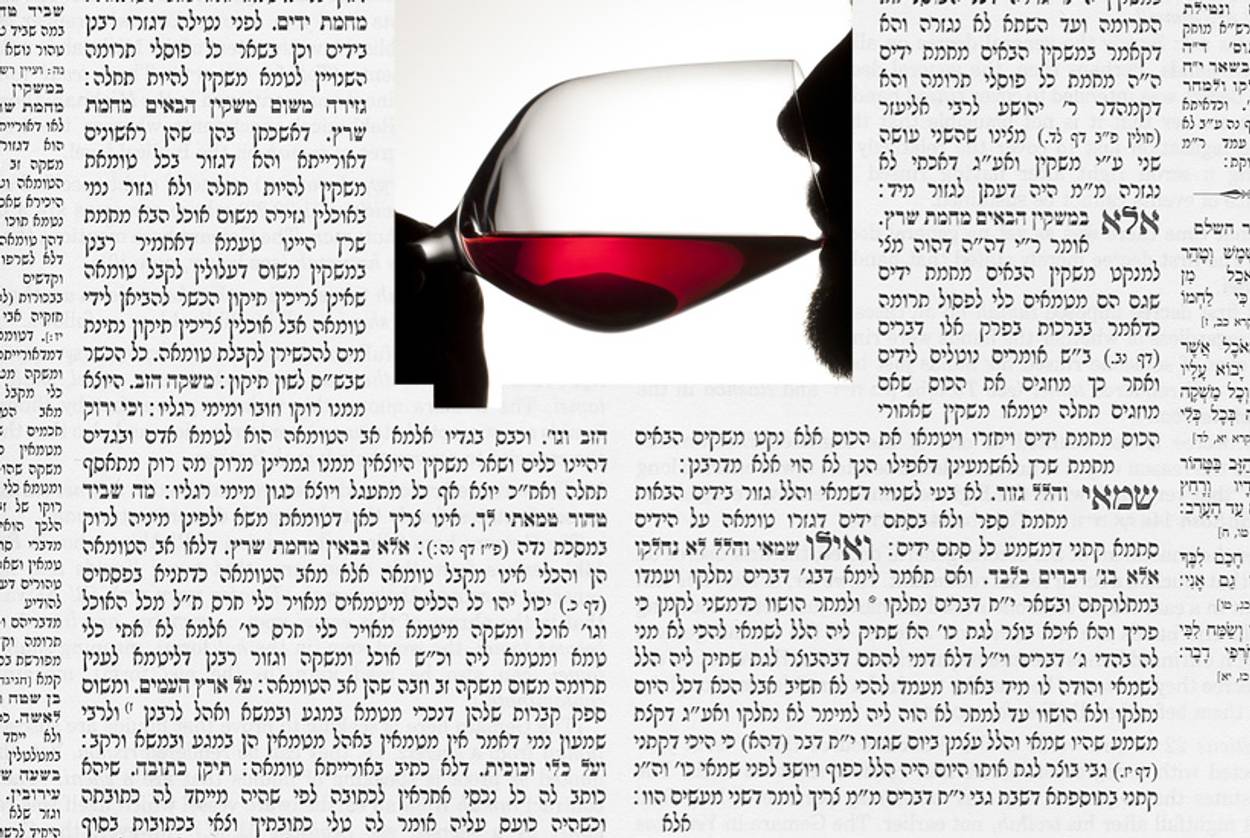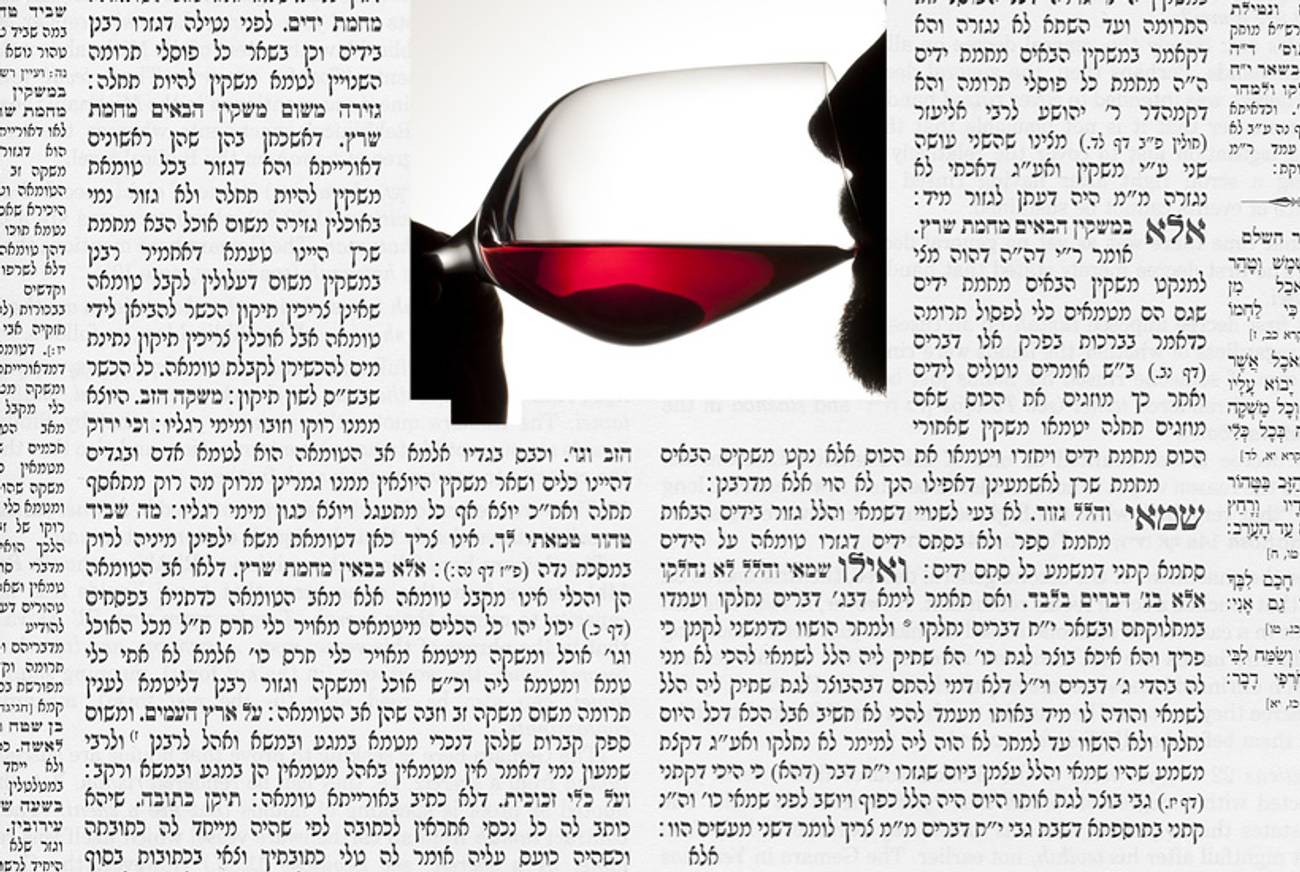When the Rabbis Do Things by the Book, They Give the Talmud Its ‘Talmudic’ Qualities
In this week’s Daf Yomi, deference, privilege, and the appearance of impropriety from the rabbis of ancient Jewish society




Literary critic Adam Kirsch is reading a page of Talmud a day, along with Jews around the world.
Near the end of this week’s Daf Yomi reading, the Talmud offered an anecdote that sheds light on the rabbis’ ideas about good manners. Rav Huna, we read near the end of Chapter 7 of Tractate Pesachim, once came to the house of Rav Nachman bar Yitzchak and proceeded to break a number of the unwritten rules that constitute the etiquette of any society. When asked his name, he replied “Rav Huna”—even though, the Koren Talmud explains, “using his title appeared to show conceit.” When invited to sit down, he immediately sat, instead of refusing at least once for the sake of politeness. Again, when offered a cup of wine, he said yes right away. Then he made matters worse by draining the glass in two sips—and he drank while facing the company, instead of turning away modestly to drink in private.
All these things, we are clearly meant to understand, were bad manners, and that is how they appeared to the company at Rav Nachman’s. But the Talmud proceeds to turn the tables on our expectations, so that Rav Huna turns out not to have been rude after all. On the contrary, when asked, he gave good reasons for each of his transgressions. He called himself “Rav Huna,” rather than just Huna, because “I am known by that name”—he was just being factual, not bragging. He sat down after one request in order to show deference to his host, Rav Nachman: “Anything the master of the house says to you, do.”
Likewise, he drank wine after one invitation because “One may refuse a lesser person, but one may not refuse a great person.” He emptied his glass in two sips because that is how we are supposed to do it, according to a baraita: “One who drinks his cup at one time is a guzzler; two is proper manners; three is haughty.” And finally, he did not turn away from the company while drinking because “we learned in the Mishnah that a bride turns her face”—and since he was not a bride, the rule of modesty didn’t apply to him.
This is one of those episodes that preserves, like a fly in amber, a little bit of the day-to-day life of Talmudic-era Jews. As we have already seen in a variety of contexts, issues of deference played a major role in ancient Jewish society, especially when it came to men like the rabbis, who were at the top of the social hierarchy and tended to insist on their privileges. With this in mind, the story teaches a double lesson. Great men like Huna should not behave in an entitled and inconsiderate fashion; at the same time, we should not be too quick to assume that what looks like bad behavior really is, especially coming from a sage.
The rabbis must have considered this valuable wisdom, because they went pretty far out of their way to include it in the Talmud. The connection between Huna’s immodesty and the main subject of Chapter 7—the proper way to perform the Passover offering—lies in a small detail: the rule that “a bride turns away her face.” It is not entirely clear whether this is a description or a prescription. According to the Koren Talmud’s notes, there are two interpretations of the sentence. One holds that a new bride who is embarrassed at being the center of attention is allowed to hide her face; the other holds that she is required to hide it, as an expression of modesty.
The ambiguity here seems fitting, given the Talmud’s conflicting attitudes toward women and their public presence. On the one hand, we saw in Tractate Shabbat that women are expected to adorn themselves with jewelry and fine clothes and that it is even a husband’s duty to give his wife these things. On the other hand, we learned that a woman may not sing in public, since her voice would be too erotically exciting for men to endure. In general, the Talmud seems to give women a lot of latitude inside of marriage, very little outside it; and since a bride is still getting used to her role as a married woman, the rabbis expect her to remain bashfully hidden.
“We learned in the Mishnah that a bride hides her face,” Huna says, and the Mishnah in question comes in Pesachim 86a, during a discussion of the proper way to eat the Passover sacrifice. As we have already seen, in Temple times groups of Jews would bring a lamb or kid to Jerusalem and register to eat it together. Every Israelite had to be registered for a particular sacrifice, and people could not eat animals for which they had not signed up in advance. Here, the rabbis ask what happens when two different groups, who have registered for different sacrifices, eat their meals in the same house. Won’t it look to outsiders that they are just one group and that they have ignored the rules about registration?
This kind of concern comes up surprisingly often in the Talmud: Many laws are formulated to avoid the appearance of impropriety. In this case, the Mishnah instructs that the two groups should advertise their separateness by facing away from each other: “These turn their faces this way and eat, and these turn their faces that way and eat.” But what if there is a new bride present? She might want to turn her face away from her group, out of modesty; but she would be afraid that in doing so she would appear to be part of the other group and thus in violation of the rules about eating the Passover sacrifice. For her sake, the Mishnah is explicit: “And the bride turns her face and eats,” even if this makes it look like she is not part of her group.
There is a remarkable thoughtfulness in evidence here. Some unidentified Tanna took time to empathize with a bride on Passover and designed the rule to accommodate her. But then, one of the Talmud’s defining traits is its need to lay down rules to cover even the most unlikely contingencies. Another example of this came earlier in Chapter 7, in Pesachim 79a. Most Temple sacrifices could not be performed in a state of tumah, or ritual impurity; but the Passover sacrifice was so important that this requirement was suspended. If a majority of the Jewish community was impure, the whole people could go ahead and make the sacrifice. If, on the other hand, only a minority was impure, then the majority that was pure (tahor) should make its sacrifice alone; and the following month, a day was set aside for the impure minority to make up the sacrifice once they had regained their purity.
But the Gemara is concerned about another possibility. What happens, the Amoraim ask, when the Jewish people is divided exactly in half, with one half pure and the other impure? Now there is no majority and no minority! One might respond, pragmatically, that this would never actually happen, since the odds of an exact division are so small. Furthermore, I wondered about how those in charge of the sacrifices could ever find out exactly how many people were tamei. After all, the Passover festival brought upwards of a million Jews to Jerusalem, and they weren’t all standing still to wait for their purity status to be determined.
But the Talmud never allows such merely practical questions to stand in the way of the law. Every conceivable problem must be addressed, even ones so unlikely that spending time on them seems perverse. (This is one of the qualities that makes the Talmud “Talmudic,” in the faintly pejorative sense that word carries in English.) So, over the following pages, the rabbis go back and forth on the subject of “half and half.” Should each half be treated as a majority, as Rav says, so that the pure and the impure each sacrifice on their own? Or should each half be treated like a minority, as Rav Kahana says, so that the impure simply lose out on their chance to offer a sacrifice?
Finally, Rav offers an ingenious solution to the problem. If the community is exactly divided between tahor and tamei, pure and impure, then they should pick one of the pure people and deliberately contaminate him by exposing him to a sheretz, one of the species of “creeping animals” that communicate tumah. In this way, the deadlock is broken and the sacrifice can proceed smoothly. Ulla replies that, rather than deliberately render someone impure, the community can simply order one of the pure people to leave town, which would also break the tie. But the Gemara sides with Rav: It is easier to simply use a sheretz. When the law does not fit reality, the Talmud says, we do not alter the law, but the reality—a counter-intuitive approach, but one that highlights the rabbis’ commitment to doing everything by the book.
***
Like this article? Sign up for our Daily Digest to get Tablet Magazine’s new content in your inbox each morning.
Adam Kirsch is a poet and literary critic, whose books include The People and the Books: 18 Classics of Jewish Literature.
Adam Kirsch is a poet and literary critic, whose books include The People and the Books: 18 Classics of Jewish Literature.